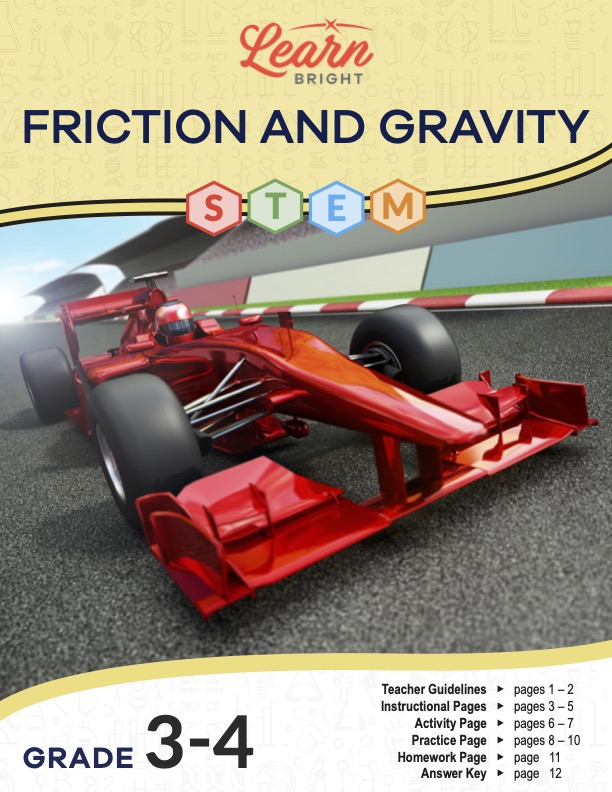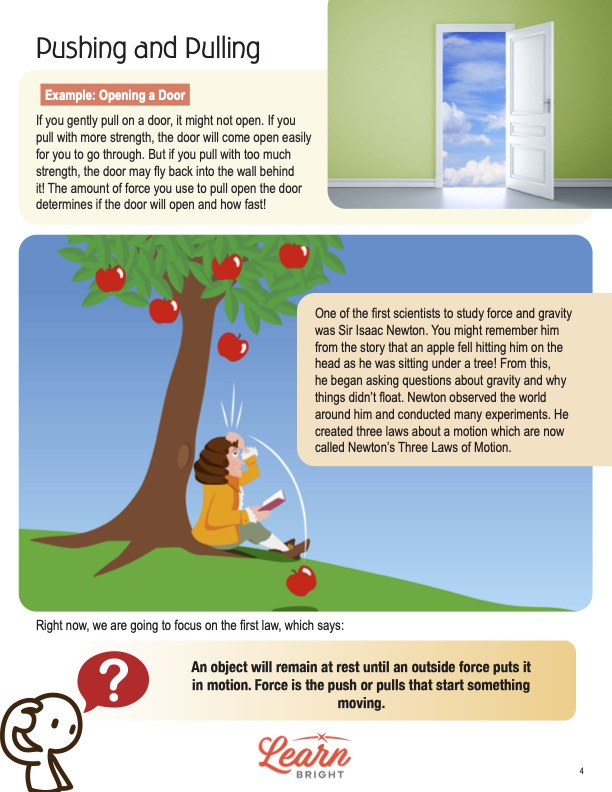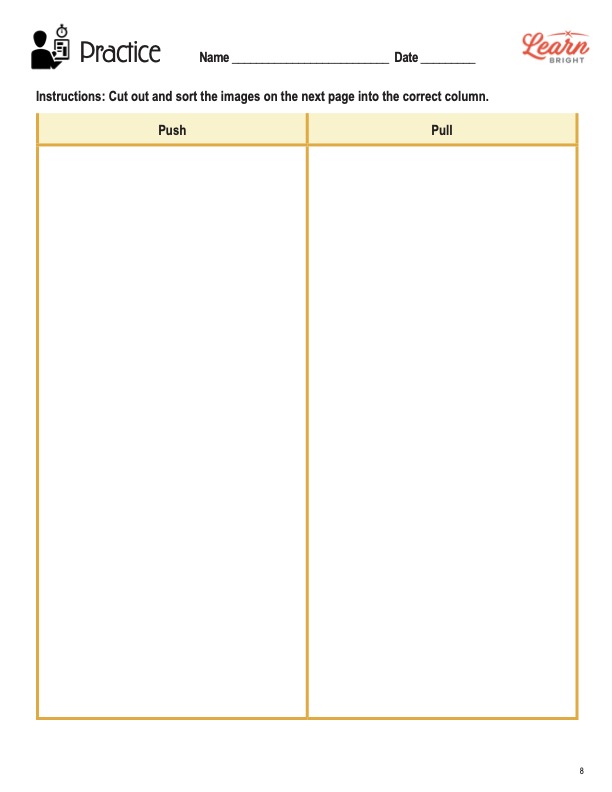Description
What our Friction and Gravity STEM lesson plan includes
Lesson Objectives and Overview: Friction and Gravity STEM explores the natural forces of pushing, pulling, gravity, and friction. Students will discover the differences between these concepts. They will also learn how they interact with each other in nature. This lesson is for students in 3rd grade and 4th grade.
Classroom Procedure
Every lesson plan provides you with a classroom procedure page that outlines a step-by-step guide to follow. You do not have to follow the guide exactly. The guide helps you organize the lesson and details when to hand out worksheets. It also lists information in the yellow box that you might find useful. You will find the lesson objectives, state standards, and number of class sessions the lesson should take to complete in this area. In addition, it describes the supplies you will need as well as what and how you need to prepare beforehand. For this lesson, you need sand, grass, dirt, concrete, golf balls, tape measures, scissors, and glue sticks or tape.
Options for Lesson
The “Options for Lesson” section of the classroom procedure page lists a number of suggestions for ideas and activities you could incorporate into the lesson. One idea is to have a personal trainer come in and talk about how the different muscle groups push and pull when you move your body. Then have students move their own bodies to explore how other muscles work together. If possible, another options is to project the muscles on the board and highlight them in each activity. One more idea is to have students watch a video of a marionette to see how the puppeteer pushes and pulls the strings to move it. There are lots of great videos for students to see online that can supplement this lesson as well.
Teacher Notes
The paragraph on this page gives you a little more information on the lesson overall and describes what you may want to focus your teaching on. It mentions that this lesson focuses specifically on the forces of friction and gravity on simple objects. The blank lines are available for you to write out any thoughts or ideas you have as you prepare.
FRICTION AND GRAVITY STEM LESSON PLAN CONTENT PAGES
Pushing and Pulling
The Friction and Gravity STEM lesson plan contains three content pages. To start off, the lesson presents a couple of questions to the students. Have they ever been told not to push in line or pull someone’s hair? These two actions are both forces. A force makes an object speed up, slow down, remain in place, or change direction or shape.
Pushing and pulling are just two of these forces. Pushes and pulls are forces that act in opposite directions. Both living and non-living objects are capable of pushing and pulling. The two forces balance one another, meaning that the total effect of all pushes and pulls is equal. And this applies to both stationary objects and objects that move with unchanging speed and direction.
Pushing a swing is an example of a push. When a parent pushes a child on the swing, the force of the push moves the sing in a certain direction—up. The harder they push, the higher the swing will go. The reason we sometimes ask the person pushing us to push harder is that we want to swing higher.
Opening a door is an example of a pull. If we gently pull on a door, it might not open. If we pull with the necessary amount of strength, it can open easily. However, if we pull with too much strength, the door can fly back into the wall behind it. The amount of force we use to pull open a door determines if the door will open and how quickly it will do so.
Laws of Motion
One of the first scientists to study force and gravity was Sir Isaac Newton. Students will likely be familiar with the story of an apple falling from a tree and hitting Newton on the head. The experience he had while sitting beneath the tree led him to ask questions about gravity and why things didn’t float.
Newton observed the world around him and conducted lots of experiments. He developed three distinct laws about motion that we now consider the three laws of motion. Friction and gravity specifically have to do with the first law of motion. Within the law, it states that an object at rest will remain at rest unless an outside force puts it into motion. Force is the push or pull that gets something to move.
Students will learn that friction is the force that heats things up. When we are cold, rubbing our hands together quickly makes them warm up. This is because this action creates friction between our hands, making heat. Friction is the force that resists motion; it slows things down or stops things from moving. Less force yields less friction, and more force yields more friction.
Gravity is the force that holds things down by pulling them toward the center of the earth. This force keeps us and everything else from floating off into space. It is the reason a ball will come back down if we toss it into the air. Then again, it’s also the reason our food falls to the floor when we drop it.
Friction and Gravity in Action
To further illustrate these concepts, the lesson describes a bike race on an asphalt road. It is fairly easy for the bikers to push the pedals and cruise at high speed. The friction that generates between the tires and the smooth road is not enough to slow them down. However, riding on a sandy beach would be an entirely different story.
If we try to ride a bike on sand, we would likely struggle to push the pedals and cruise along the beach. This is because the sand causes friction with the bike tire. Professional bikers know that reducing friction will allow them to ride faster. Therefore, they use light materials to make the bike and use skinny tires to reduce the amount of contact with the road.
Friction happens when two solid materials rub together. In the case of the bike riders, the bike wheel against the asphalt road causes only a little friction. The bike wheel against sand, however, causes a lot of friction. Friction can also occur when two states of matter move past each other, like air over a race car. Race cars are sleek and curved for a reason. Their shape reduce friction between the car’s surface and the atmosphere.
FRICTION AND GRAVITY STEM LESSON PLAN WORKSHEETS
The Friction and Gravity STEM lesson plan includes five worksheets: three activity worksheets, a practice worksheet, and a homework assignment. Each one will help students solidify their grasp of the material they learned throughout the lesson. You can refer to the classroom procedure guidelines to know when to hand out each worksheet.
GOLF BALL FRICTION TEST ACTIVITY WORKSHEET
Students will experiment with a golf ball to test the friction of the ball on four different surfaces. They will have three tries for each surface—dirt, concrete, grass, and sand. To be as accurate as possible, they should aim to push the golf ball with the same amount of force on each try. After they record the distances in the boxes on the chart, students will color the box with the longest distance green and the shortest distance red. Then they will answer a series of questions regarding the information they observed.
PUSHING AND PULLING IMAGE SORT PRACTICE WORKSHEET
For the practice worksheet, students will cut out images on the image page and sort them into the correct column. There are 12 images total; six will belong in the push column and six will belong in the pull column. You are welcome to let students work in pairs or groups for this assignment.
FRICTION AND GRAVITY STEM HOMEWORK ASSIGNMENT
The homework assignment requires students to think about or observe actions that involve pushing and pulling in various situations. What examples might they see at a grocery store, during dinner time, while playing a sport, or when coloring a picture? You could provide sample answers to give them an idea of what to look for.
Worksheet Answer Keys
The lesson plan document includes answer keys for the three worksheets. All the correct answers are in red to make it easy to compare them with students’ work. There are only two responses on the activity worksheet that should match the answer key since there are specific right answers for them. The answer key for the homework assignment provides sample responses that relate to each of the four scenarios, but students’ answers will vary. If you choose to administer the lesson pages to your students via PDF, you will need to save a new file that omits these pages. Otherwise, you can simply print out the applicable pages and keep these as reference for yourself when grading assignments.









